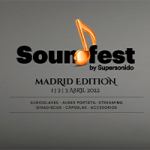Fiio K9 PRO ESS DAC HEADPHONE AND DAC REVIEW
Janine Elliot takes a listen to the £700 Fiio K9 PRO ESS headphone and DAC.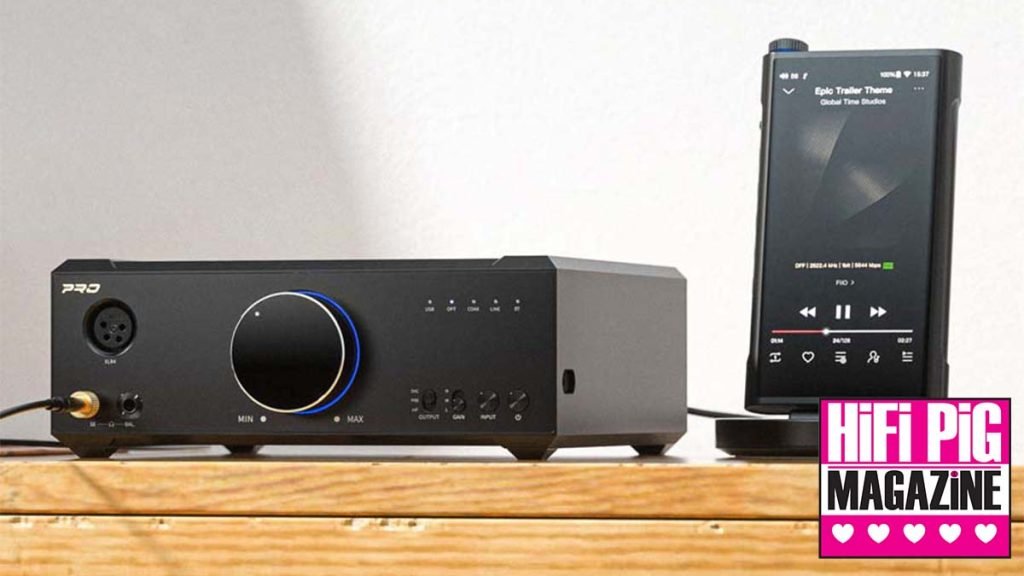
You’d think I was reviewing a fictional robotic canine with a name K9 (Doctor Who fans will get this), but this DAC/headphone amp is anything but imaginary, and comes from the Chinese company Fiio. I personally own an aged X1 and X5 DAP. In the house, I use the X5 line output into a Slee Voyager headphone amp and get a very reasonable sound. I have watched this company grow since its early beginnings in the UK, starting with basic DAPs and headphone amps and now growing into producing some of the best-looking and technological personal products out there. Indeed, looking at the products over the last few years has seen Fiio produce some amazing kit to take on the competition. The K9 Pro ESS is their flagship Hi-Res desktop and comes in at a very good £699.99.
Guangzhou FiiO Electronics Technology Co., Ltd was established in 2007 in Guangzhou City, China, and has moved away from just doing DAPs to cables, amplifiers, and earphones. The name Fiio is made up of “Fi” for fidelity and “io” to represent the digital language of ones and noughts. Clever.
BUILD QUALITY OF Fiio K9 PRO
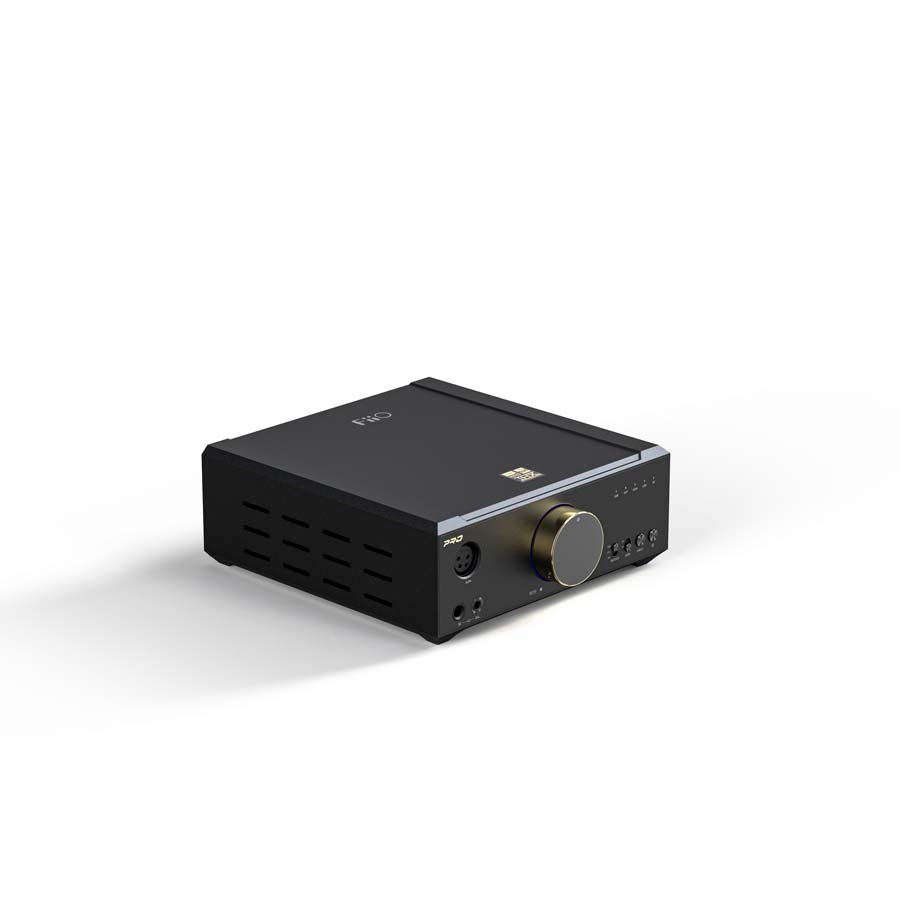
The K9 Pro ESS is small, compact, and well put together
The K9 Pro ESS is one up from the K9 Pro. It uses two well-respected ESS ES9038 Pro DACs, one per channel, rather than the base model’s AK4499. All in all, the Pro ESS adds up to better THD, SNR, and a slightly greater output level (2100mW into 32 ohm). The body is beautifully presented with gold-edged central volume knob on the front (as opposed to silver on the base model) and vents at the side of the unit with slightly raised ridges along the edges. It looks well thought out. The unit comes with 6 stick-on feet for you to add if you decide to use the unit horizontally, or not if you put the unit on its side on the supplied stand. The unit also comes with a spare fuse.
This is a truly balanced design with a dual voltage linear transformer and supports SBC, AAC, LDAC, aptX Adaptive, and aptX HD Bluetooth codecs, as well as WAV/Flac/DSD/MQA sampling rates. With output connectors (XLR 4pin and 4.4mm balanced plus standard SE ¼” on the front left, the right-hand side has the input selector plus gain (low/mid/high) and output selectors (DAC/PRE/Headphones). Other controls include input selector and standby. Above this are LEDs to indicate the input source (USB/Opt/Coax/line/BT). In the middle is a large volume control with a colour-changing RGB backlight surround to indicate sampling rates and Bluetooth codecs.
At the rear of the unit are the inputs including coaxial, optical, USB, and a Bluetooth digital aerial socket plus RCA and balanced 4.4mm analogue inputs, plus RCA and XLR analogue outputs should you want to connect to an amplifier or your powered speakers. On the side is a USB C port to connect to your mobile device for more control via an app.
The phone app controls Bluetooth codecs, DAC filters etc. K9’s amplifiers are the excellent THX AAA-788+ chips that can give exceptionally low distortion and excellent detail and dynamics when using both low and high-impedance headphones. Indeed, the amp works well with headphones/IEMs from 16 to 600ohm. The PCB is a partitioned layout meaning that the power supply and signals are separated, including analogue and digital stages. The balanced audio circuitry is equally complex with 6 stages from input to output. A dual-mode clock management design is deployed with a femtosecond clock for USB/Bluetooth and PLL clocks for optical and coaxial decoding. Typical of products at this price point, USB operates up to 384kHz-32bit/DSD256, coaxial up to 192kHz-24bit, and optical 96KHz-24bit. The unit also supports MQA tracks which given the recent news is moot. A Qualcomm QCC5124 looks after the Bluetooth ensuring it is low latency for gamers and high bit rate for audiophiles. Finally, the Fiio uses an internal linear power supply with four massive 4700uF capacitors.
The presentation box itself is crammed with goodies including a power cable, 3.5mm adaptor, BT aerial, spare fuse and the custom stand so that you can sit the PRO on its side, should you wish to save space. At 200 x 220 x 72mm, this is a very compact but well-laid-out unit. The presentation is very good including a basic but good sized instruction manual.
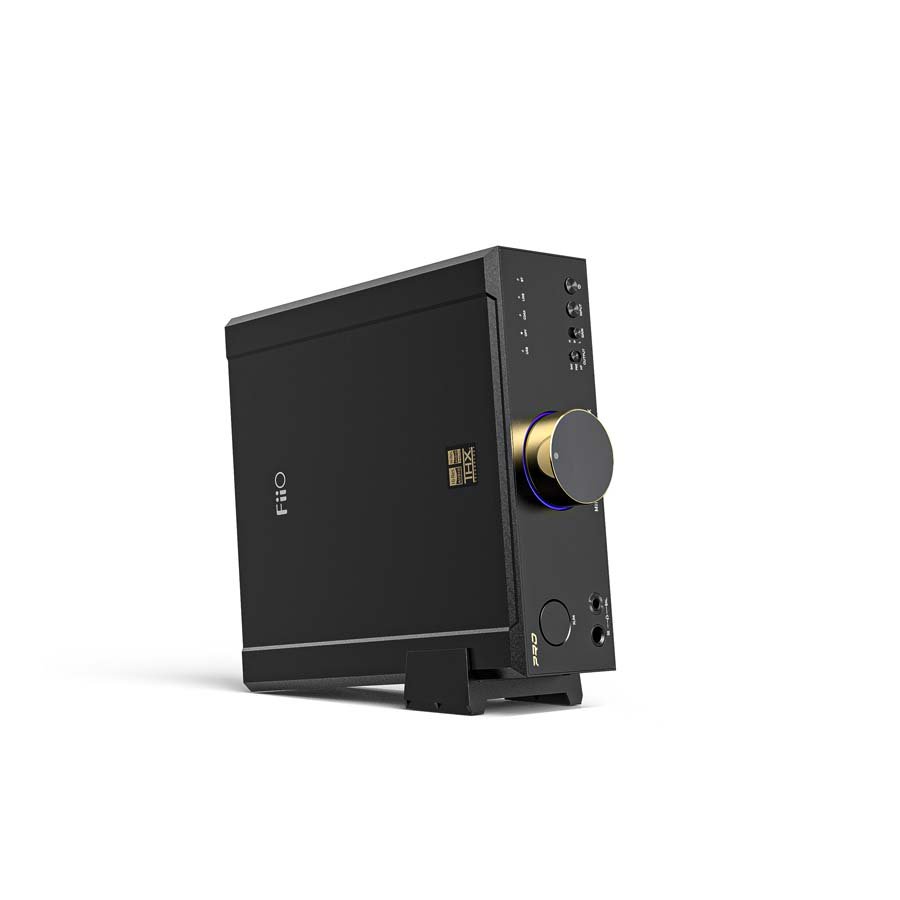
The included stand allows for vertical mounting
SOUND QUALITY
Getting it out of the box, the only clue to it being the ESS version was the gold rim of the volume control and gold “PRO” badge. The word “ESS” appears on the base, as does a 110v and 230v switch, which I carefully checked before turning on. For most of the listening, I used Coax and BT. Initially, I set up the Fiio X5 digital output, which actually performed surprisingly well. Other than that, I used the excellent SE180 DAP from Astell and Kern, itself also affording an ESS ES9038PRO DAC, and I listened with Sennheiser, Audio Technica, Meze, and Campfire Audio headphones/IEMs. Turning on the unit is via a toggle switch at the back plus the standby button at the front right. Instead of pressing the latter, you can also turn the volume control to wake it all up. Nice idea. The RGB edge then changes colours until it tunes into whatever the input is. For example; “white” is LDAC, and “Green” is DSD.
The first of the digits were Johnny Cash’s “The Man Comes Around” (24bit/96kHz). With excellent detail and an impressive spread of instruments, Johnny’s voice was hypnotic as he spoke and sang. There are three levels of gain on the K9 front panel (indeed, all the switches are rather small but keeps the front panel looking minimalist), and for most of the time I used the “high” setting and my Sennheiser HD650’s needed to be at ½ way on the dial to get a serious level of sound. Indeed, for Dave Brubeck’s ‘Blue Rondo’ I needed to turn it up to 2 o’clock. The amp, however, should be ok with all but the most inefficient planar headphones.
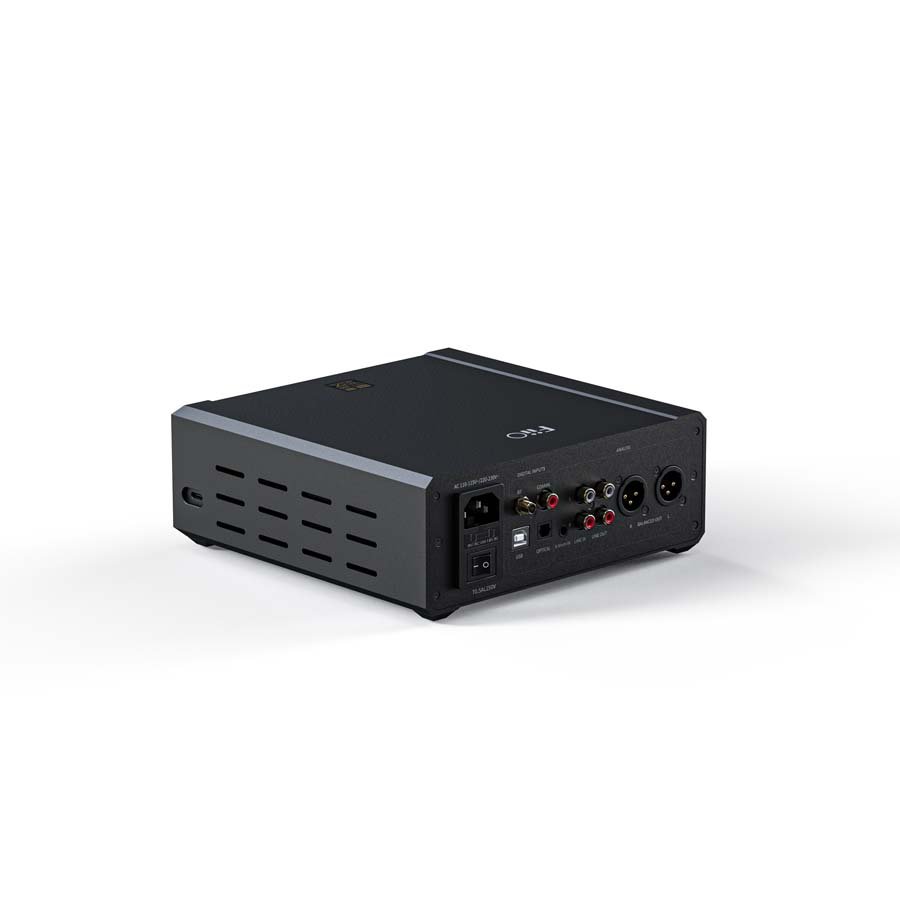
Around the back of the Fiio K9
Julia Fordham’s “Porcelain” is a very laid-back album with great sounding vocals and instruments. The cymbals were very tight and Julia’s distinctive voice – especially the low notes – was very honest sounding. The Fiio gave a very good performance, if a little gentler than I remember. This was very musical but a tad too tidy and cleaner than I expected. I wanted a little more oomph and musicality to get me really engrossed, but this was soon to be experienced with Kitaro’s ‘Live in America’, another very laid-back album with lots of interesting sounds such as thunder, synthesizers, and audience applause in this live performance, giving it an air of ambiance and enchantment. That bass thunder was superbly tight and clear as were the strings, synths, and woodwind. I just felt the bass was a little quieter than I would like, even when using the bass-brilliant Meze 99 headphones. The top end from the synthesizers and audience claps were very clear and the exceptionally quiet running THX AAA-788+ made this a joy to experience, even at loud listening levels. Certainly, the mids and higher frequencies are clearer, though could sound rather more digital than I would like, depending on what I played.
Kraftwork’s “Autobahn” was an old favourite back in 1974 and quite unique at the time. Playing it now seemed inevitably dated and even the sound quality sounded harsher than from the top DACs I have used over the years. It sounded better on vinyl. No surprise there, I guess. On 44.1kHz WAV it just sounded a little less interesting and musical. I had to turn it right up to get any sense of enjoyment.
Let’s try more synthesisers combined with guitars and drums; Hawkwind’s Hall of the Mountain Grill. Again, the volume of this recording had to be raised midway for the HD650’s. The piano on the title track was accurate and the overall quality was excellent. The Fiio gave a startlingly good performance of this track, and again this was a very quiet running headphone amp at 129dB.
Turning to jazz and Herbie Hancock’s Crossing album and “Sleeping Giant” I was awakened immediately by the solo drum that starts the track. Transients were fast and accurate, and the music was quickly followed by electronics and an almost musique concrète idiom. This work might not have a melody you can sing along to, but it does have great rhythm if you want to dance. I didn’t bother doing that but listened to this very long track (it’s 24’ 48”!) with great interest. This Fiio was really growing on me, especially as this track was mp3. The sound quality was excellent and I didn’t feel perturbed by the compressed format. The HD650 might be an old headphone but it still does the job. Everything was there from the deepest bass guitar to the cymbals. The keyboard (Fender Rhodes) was beautifully tight and flowed beautifully.
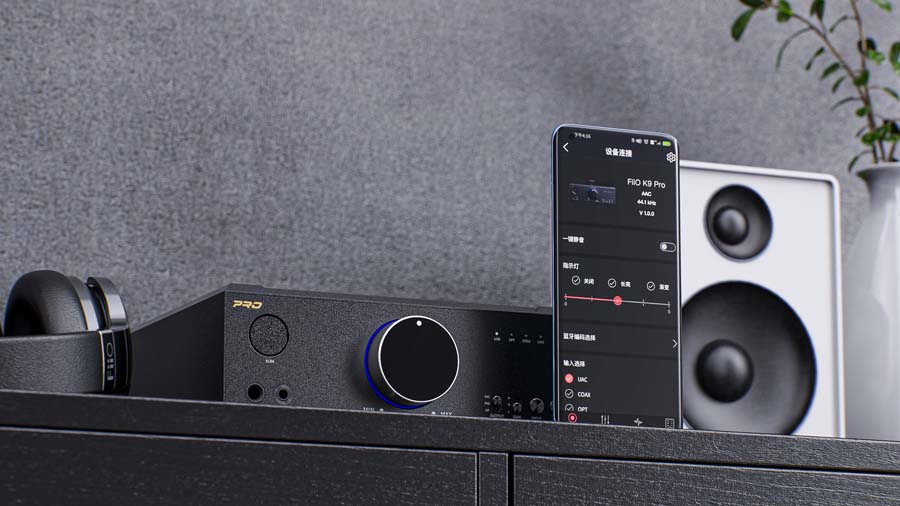
The K9 Pro ESS in use
Now turning to Tchaikovsky’s 6th symphony for a breather. This lovely work starts at low volume and takes some three minutes before it wakes up. The Audio Technica ATH W1000 headphones are more efficient than the Sennheisers, but I still needed to turn up the volume to get enough welly. For more gusto I turned to Eugine Goosen’s 1959 rendition of Berlioz Symphony Fantastique. This is a truly powerful work and the 24bit/96kHz recording still had all the noises you’d expect from the original master tape recording plus the sounds of the instrumentalists breathing and turning pages. Even a few hums from the conductor added to this excellent audio. I had noticed so far in my listening that turning the volume control had a delayed reaction, and turning down the volume at speed resulted in a staggered decrescendo. This wasn’t something I was too concerned at, but worthy of note.
Turning to BT I decided to test that lower bass again with the Meze 99 Classic with Sting’s “Brand New Day”. This starts with an extremely low and loud ‘burble’ that sets the scene for the track. I felt the vibration clearly but it didn’t yell at me. It was too well controlled. Again with the top-end Campfire Solaris “Stellar Horizon” IEM the bass was again excellently controlled and the music flowed brilliantly. Top frequencies including cymbals were tight and gave a highly forensic analysis of the music. Only mid frequencies sometimes didn’t sound as musical as I would like. With Hotel California (Eagles 24/96 FLAC) whilst controlled and detailed the mid frequencies again just slightly lacked. So too, turning to Chopin Piano Concerto No1, (Ingrid Fliter, 24/192 Linn records) the mid-frequency violins lacked a little oomph, though I know Linn recordings have their own individual sound quality, so I somewhat expected it, but not quite as much. That said, the piano was detailed and very musical with starts of notes and decays extremely accurately. I didn’t want to stop listening.
Turning to DSD and “A Trace of Grace” (Michel Godard) this slow piece had excellent spread across the soundstage with violin, sax, and brass. This was very open and the K9 showed extreme care with the musical performance. The Fiio was honest and what i would consider to be very accurate, particularly with transients and detailed high frequencies. Bass was controlled and real. Finally, I tested out MQA on the K9 ESS, and Beagle Kick’s Miracle album. This album has excellent jazz piano, guitar, and drums. Whilst MQA might be having a somewhat uncertain future as I write this, the performance through the Fiio was anything but. I actually quite like the sound from MQA even if it is a bit marmite to some, and the Fiio gave an excellent rendition that was highly engrossing and very musical. Playing the Fiio as a preamp into my Synthesis valve amps added even further to my enjoyment of this music.
CONCLUSION
This is a really good attempt to produce a detailed and quick DAC with excellent amp stages and plenty of features. It even worked well as a pre amp. Everything was there in the music – warts and all at times – but that is the sign of a good product; it was very honest. Only the mid frequencies didn’t give me the sonic prowess to give it the very top marks but for a penny short of £700 this is an excellent, and very good looking, DAC/headphone amp.
AT A GLANCE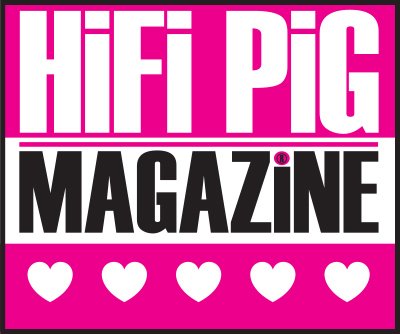
Build Quality:
Excellent build quality
Sound Quality:
An exciting and transparent performance, with masses of detail particularly at high frequencies
Value For Money:
For £699.99 this is a very well-designed and full-featured DAC/Pre/headphone amp
An excellent product
We Loved:
Transparency
Speed of performance
Control at lower frequencies
Lowest distortion and excellent S/N ratio
Excellent presentation
We Didn’t Love So Much:
Slightly digital presentation at top frequencies on a few pieces I played
Elevator Pitch Review
I have been a customer of Fiio in the past and have watched their product range turn from the average to a top-flight producer of DAPs, DACs, and headphone amps that they are today. Would this flagship hi-res desktop headphone amplifier/DAC fair even better than my expectations? You bet. Including the ES9038PRO DAC chip from ESS and the THX AAA 788+ amp chipset, this has a well-stocked PCB so should make a very decent sound for the price.
Price: £699.99

Janine Elliot
Equipment Used: Astell and Kern SE180 SEM1 (coax and BT connected DAP), Fiio X5 (coax connected DAP); Sony Xperia (BT phone), Sennheiser HD650, Audio Technica ATH W1000 Sovereign, Meze 99 Classic (headphones); Campfire Solaris Stellar Horizon (IEM); Synthesis Roma 98DC (valve power-amp) and Graham Audio LS5/9 (speakers)
Technical Specifications
Form: Desktop DAC Amp
DAC Chipset: ES9038PRO x2
Amp Chipset: THX AAA 788+ x2
Bluetooth Chipset: QCC5124
USB Chipset: USB: XMOS XUF208
Digital Inputs: USB-A, USB-c, coaxial, optical, Bluetooth 5.0
Sample Rate Support: 384kHz-32bit/DSD256 (USB), 192kHz-24bit (coaxial), 96KHz-24bit (optical)
Analog Input: RCA and 4.4mm balanced
Analog Output: RCA, 3-pin XLR x2, 4-pin XLR (balanced), 4.4mm (balanced), 6.53mm (SE)
Recommended Headphone Impedance: 16~600 Ω
Output Power: 2.1W @16Ohms (SE), 281mW @300Ohms (SE), 2.1W @32Ohms (balanced), 1.1W @300Ohms (balanced)
THD+N: ≤0.00025%
SNR: ≥129dB
Weight (g): 2750g
Dimensions: 200 x 220 x 70mm
















































